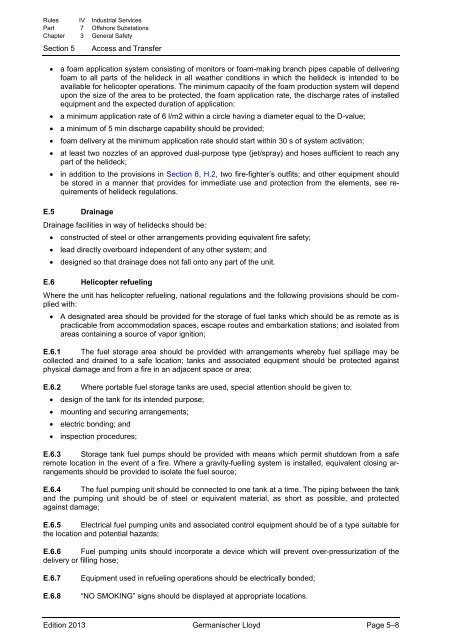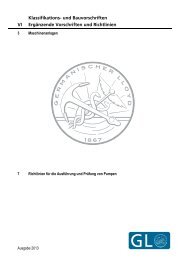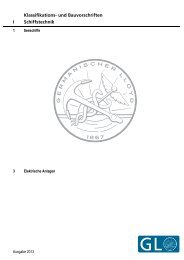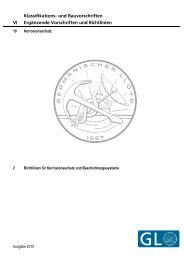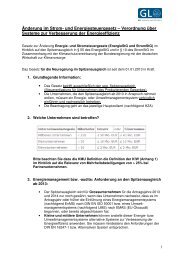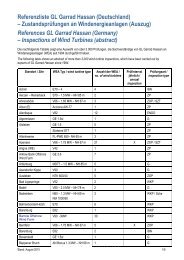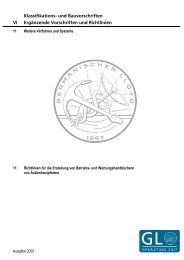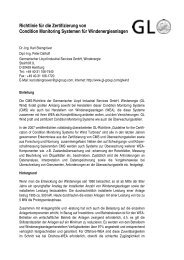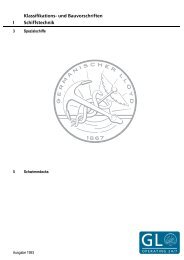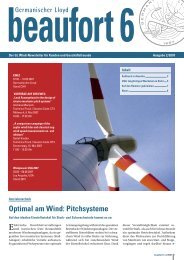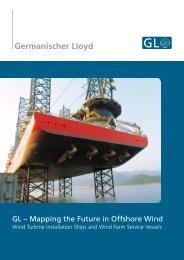(IV-7-3) General Safety
(IV-7-3) General Safety
(IV-7-3) General Safety
You also want an ePaper? Increase the reach of your titles
YUMPU automatically turns print PDFs into web optimized ePapers that Google loves.
Rules <strong>IV</strong> Industrial Services<br />
Part 7 Offshore Substations<br />
Chapter 3 <strong>General</strong> <strong>Safety</strong><br />
Section 5<br />
Access and Transfer<br />
• a foam application system consisting of monitors or foam-making branch pipes capable of delivering<br />
foam to all parts of the helideck in all weather conditions in which the helideck is intended to be<br />
available for helicopter operations. The minimum capacity of the foam production system will depend<br />
upon the size of the area to be protected, the foam application rate, the discharge rates of installed<br />
equipment and the expected duration of application:<br />
• a minimum application rate of 6 l/m2 within a circle having a diameter equal to the D-value;<br />
• a minimum of 5 min discharge capability should be provided;<br />
• foam delivery at the minimum application rate should start within 30 s of system activation;<br />
• at least two nozzles of an approved dual-purpose type (jet/spray) and hoses sufficient to reach any<br />
part of the helideck;<br />
• in addition to the provisions in Section 8, H.2, two fire-fighter’s outfits; and other equipment should<br />
be stored in a manner that provides for immediate use and protection from the elements, see requirements<br />
of helideck regulations.<br />
E.5 Drainage<br />
Drainage facilities in way of helidecks should be:<br />
• constructed of steel or other arrangements providing equivalent fire safety;<br />
• lead directly overboard independent of any other system; and<br />
• designed so that drainage does not fall onto any part of the unit.<br />
E.6 Helicopter refueling<br />
Where the unit has helicopter refueling, national regulations and the following provisions should be complied<br />
with:<br />
• A designated area should be provided for the storage of fuel tanks which should be as remote as is<br />
practicable from accommodation spaces, escape routes and embarkation stations; and isolated from<br />
areas containing a source of vapor ignition;<br />
E.6.1 The fuel storage area should be provided with arrangements whereby fuel spillage may be<br />
collected and drained to a safe location; tanks and associated equipment should be protected against<br />
physical damage and from a fire in an adjacent space or area;<br />
E.6.2 Where portable fuel storage tanks are used, special attention should be given to:<br />
• design of the tank for its intended purpose;<br />
• mounting and securing arrangements;<br />
• electric bonding; and<br />
• inspection procedures;<br />
E.6.3 Storage tank fuel pumps should be provided with means which permit shutdown from a safe<br />
remote location in the event of a fire. Where a gravity-fuelling system is installed, equivalent closing arrangements<br />
should be provided to isolate the fuel source;<br />
E.6.4 The fuel pumping unit should be connected to one tank at a time. The piping between the tank<br />
and the pumping unit should be of steel or equivalent material, as short as possible, and protected<br />
against damage;<br />
E.6.5 Electrical fuel pumping units and associated control equipment should be of a type suitable for<br />
the location and potential hazards;<br />
E.6.6 Fuel pumping units should incorporate a device which will prevent over-pressurization of the<br />
delivery or filling hose;<br />
E.6.7<br />
E.6.8<br />
Equipment used in refueling operations should be electrically bonded;<br />
“NO SMOKING” signs should be displayed at appropriate locations.<br />
Edition 2013 Germanischer Lloyd Page 5–8


